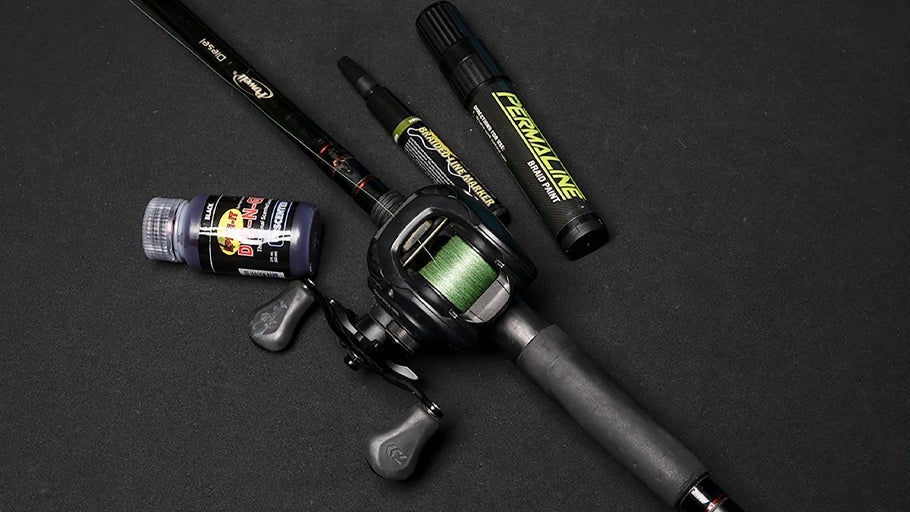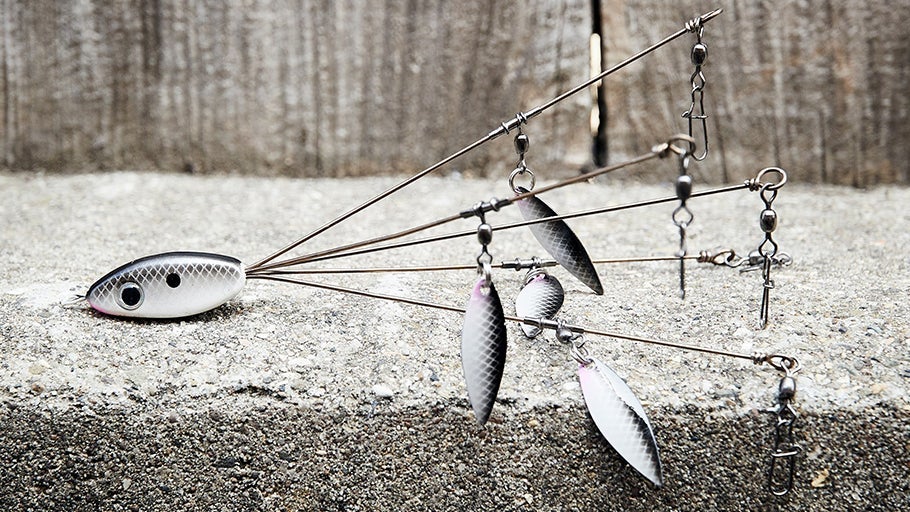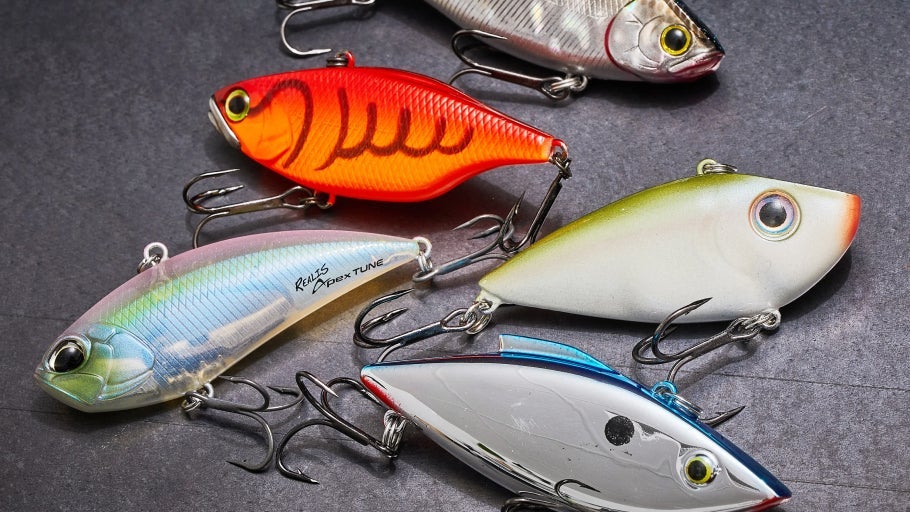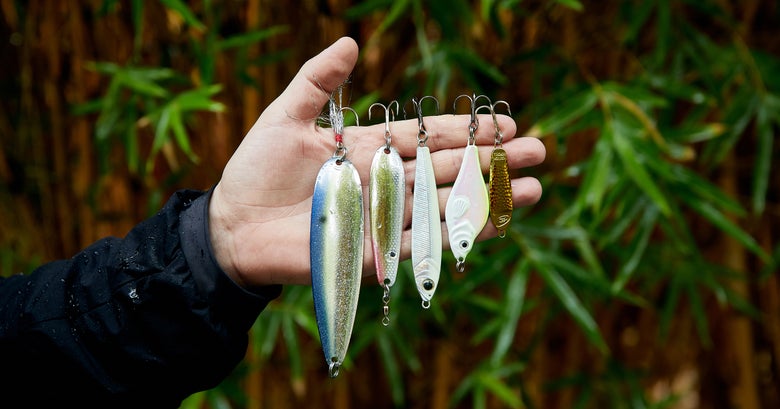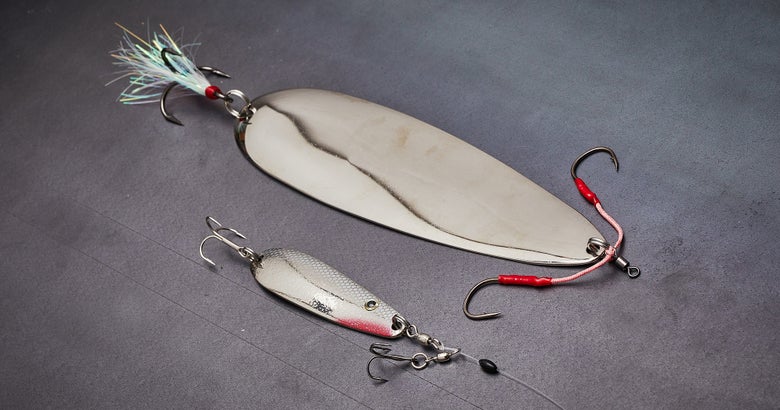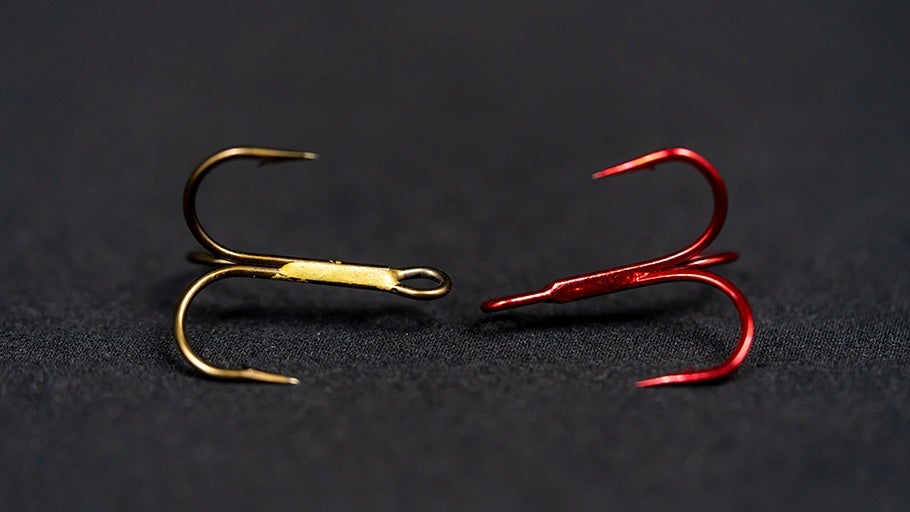
Jigging & Flutter Spoon Gear Guide
A cold-water classic that is often overlooked as a warm-water performer, spoons provide anglers with an effective tool for catching schooling fish by imitating a dying baitfish on its last legs. With bass always looking to capitalize on an easy meal, spoons offer a sure way to fill out a limit when targeting suspended or deep-water fish. Anglers generally lump spoons into two different categories: jigging and flutter spoons.
Based on a host of seasonal factors and the attitude of the fish on any given day, your approach, retrieve style, and which spoon you decide to fish may vary greatly. The aim of this guide is to break down each type of spoon and provide a specific gear recommendation to help improve your success on the water. Let’s explore why spoons are known for bagging impressive numbers of fish, and why they are also notorious for bringing in those giant bass that spark stories around the campfire.
Jigging Spoons
Most anglers only begin to consider using a jigging spoon as the weather turns cold in the fall and winter months, but this classic technique can be used to target bass effectively anytime they are actively feeding on shad or baitfish. During the summer and winter months, bass will seek the stability of deep-water environments, which are less affected by oxygen and temperature changes. The jigging spoon provides exceptional efficiency when bass move deep, as they fall quickly through the water column and rapidly reach depths of 20–60 feet.
Jigging Spoon Rods
Vertical jigging often involves heavy use of your electronics and fishing directly under your fish finder, so a shorter rod in the 7’ range can be beneficial for keeping your rod tip closer to the boat and under the transducer. Be sure to pick a rod with the perfect balance of muscle and parabolic characteristics—too soft of a rod and you’ll struggle to jig the spoon off the bottom effectively, too stiff and you could simply rip treble hooks right out of the fish’s mouth. The right medium-heavy blank with a moderate-fast to fast taper will check all of the required boxes.
Jigging Spoon Target Areas & Retrieve Technique
Start by using your electronics to locate baitfish and experiment with hopping the jigging spoon above and below the bait ball to get clued-in to how the fish are positioned. When fishing a jigging spoon vertically, oftentimes less can be more, so try to avoid overworking the lure by letting the spoon always fall on a semi-slack line to help retain its natural fluttering action. Generally, most bites will occur after the spoon begins fluttering back down to the bottom.
Flutter Spoons
While jigging spoons provide great opportunities to catch fish in extremely deep water, the flutter spoon provides an excellent way to match the hatch and capitalize on bass gorging at depths of 10–20 ft. In addition to deep-water ledges, steep drop-offs, and the offshore fishing that flutter spoons are typically associated with, the summer months also can be a great time to go even shallower and flip docks to seek out those schools of biters. Made with more surface area and a unique concave shape, the flutter spoon is designed for a slower rate of fall, and it displaces tons of water and generates an abundance of flash as it slowly descends through the water column.
Flutter Spoon Rods
Flutter spoons typically range in sizes from 1/2 to 4 oz and will necessitate matching rods to handle them. The full spectrum would include standard casting outfits all the way up to specialized heavy swimbait rods. That being said, a majority of anglers opt for flutter spoons in the 4” to 6” class and simply utilize a jig rod or light flippin’ stick in the 7’5”–7’8” range. A medium-heavy to heavy power combined with a moderate-fast tip provides the strength to work the spoon properly and the sensitivity to feel when a bass grabs your flutter spoon on the fall. Many anglers would agree that a rod with a longer handle provides the increased leverage critical for snapping the spoon off the bottom and working it aggressively through the water column.
Flutter Spoon Target Areas & Retrieve Technique
Whether you’re targeting big gizzard-eaters hunkered around offshore ledges or picking apart floating boat docks, your main objective with a flutter spoon is to trick bass into thinking they are eating a dying baitfish. In open water, use your electronics to pinpoint fish around ledges, humps, roadbeds, and other offshore targets. Position yourself as far away as possible to avoid spooking the fish or any baitfish. Line up your cast and let the spoon flutter toward the bottom on a semi-slack line. Once it hits the bottom, utilize sharp pops of the rod tip while working the spoon back to the boat, letting it fall back to the bottom after each snap. With larger spoons, some anglers will even slap their rod handle down with the palm of their hand, saving their forearms throughout a long day of fishing.
In recent years, flutter spoons have also gained notoriety for their effectiveness around floating docks in a technique known as “spoon jacking.” When fishing around docks, anglers utilize a spoon much the same way they would a stick bait: pitch it tight to cover, let it fall to the bottom, give it a couple of hops, and move on to the next target.
Jigging & Flutter Spoon Reels
Speed is vital in this technique, so be sure to use a reel that can keep up! Between the slack in the line created while hopping the spoon and the tendency of bass to ravage your lure on the fall, anglers are plagued with situations where line needs to be picked up in a hurry. A reel sporting a 7.1:1 all the way to the burner 9.1:1 gear ratio will provide the extra speed that is necessary to get a hook in some of those otherwise missed fish. The higher speed will also aid in your ability to bring your line tight quickly when a fish has knocked some slack into your line. Be sure to use a 150–200 sized reel with at least 100 yards of capacity so you have plenty of line to reach bass holding in deep water.
Jigging & Flutter Spoon Line
Fluorocarbon provides a couple of key attributes that will ensure success with this exciting technique. Well known for offering a crucial layer of invisibility for line-shy fish, fluorocarbon also incorporates a degree of stiffness that helps prevent your treble or stinger hooks from grabbing and tangling with your mainline as the spoon flutters and dances toward the bottom.
For heavy jigging spoons or magnum flutter spoons weighing over an ounce, most anglers will choose a Fluoro in the 17- to 25-lb test range. Your line size selection will invariably be dictated by the size and type of spoon you are using, so when using smaller more lightweight spoons, smaller diameter lines in the 12- to 20-lb test range may be better suited for your application.
When fishing spoons for big fish or in water deeper than 40 ft, it may be advantageous to go to a braided mainline with a fluorocarbon leader. The added strength and power of braided line will provide more hook-setting power at deeper depths while the top shot of fluorocarbon still works to disguise your presentation.
Modifications and Rigging
Always add a quality ball-bearing swivel to your spoon if one isn’t already included in the packaging. Attaching a swivel to your mainline connection will help combat line twist and reduce frustration on the water. This is especially critical on flutter spoons or any spoon that features a spiral descent pattern. Improve your hook-up ratio by adding a stinger hook directly to the nose of the spoon or by securing a treble hook directly to your line with a swivel and bobber stopper. This can be particularly important on larger spoons when the fish are eating the lure on the fall or striking just the head of the lure.
Tips & Tricks
Swapping out your treble hooks is always a great idea, especially after extended use. To maximize attraction, try upgrading your stock treble hooks with feather-dressed options, as this change may be the final bit of deception needed to convince a skeptical bass to charge at your spoon.
If your treble hook is fouling with your line tie or swivel, try covering the swivel with a small amount of shrink tubing to create a rigid connection and prevent the hook from tangling or potentially damaging your line. When fishing highly snag-ridden areas, try swapping out your treble hooks with assist hooks to increase the weedless capabilities of your spoon. Spoon fish are frequently caught when jigging deeper water, so always have a fizz needle handy if you need to deflate a bloated swim bladder.
Colors
A year-round favorite color for spoons is chrome, as it seamlessly matches a wide variety of baitfish and provides added attraction by generously reflecting light as it wobbles and flickers its way through the water column. Any kind of shad pattern can also be a great option in shad-dominant lakes, while spoons sporting bright chartreuse highlights can be particularly effective when dealing with heavily stained water or when fishing extremely deep. Start with your favorite chrome or shad patterns, but definitely have some brighter colors too, so you have options when dealing with changing water and weather conditions.

